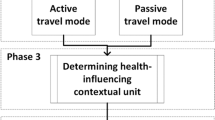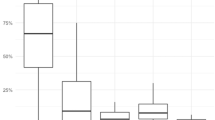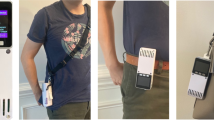Abstract
Respondent error, low resolution, and study participant burden are known limitations of diary timelines used in exposure studies such as the National Human Exposure Assessment Survey (NHEXAS). Recent advances in global positioning system (GPS) technology have produced tracking devices sufficiently portable, functional and affordable to utilize in exposure assessment science. In this study, a differentially corrected GPS (dGPS) tracking device was compared to the NHEXAS diary timeline. The study also explored how GPS can be used to evaluate and improve such diary timelines by determining which location categories and which respondents are least likely to record “correct” time–location responses. A total of 31 children ages 3–5 years old wore a dGPS device for all waking hours on a weekend day while their parents completed the NHEXAS diary timeline to document the child's time–location pattern. Parents misclassified child time–location approximately 48% of the time using the NHEXAS timeline in comparison to dGPS. Overall concordance between methods was marginal (κ=0.33–0.35). The dGPS device found that on average, children spent 76% of the 24-h study period in the home. The diary underestimated time the child spent in the home by 17%, while overestimating time spent inside other locations, outside at home, outside in other locations, and time spent in transit. Diary data for time spent outside at home and time in transit had the lowest response concordance with dGPS. The diaries of stay-at-home mothers and mothers working unskilled labor jobs had lower concordance with dGPS than did those of the other participants. The ability of dGPS tracking to collect continuous rather than categorical (ordinal) data was also demonstrated. It is concluded that automated GPS tracking measurements can improve the quality and collection efficiency of time–location data in exposure assessment studies, albeit for small cohorts.
This is a preview of subscription content, access via your institution
Access options
Subscribe to this journal
Receive 6 print issues and online access
$259.00 per year
only $43.17 per issue
Buy this article
- Purchase on Springer Link
- Instant access to full article PDF
Prices may be subject to local taxes which are calculated during checkout


Similar content being viewed by others
References
Armstrong B.K., White E., and Saracci R. Monographs on Epidemiology and Biostatistics 21: Principles of Exposure Measurement in Epidemiology. Oxford: Oxford University Press, 1994 pp. 104–109.
Dorre W.H. Time-activity patterns of some selected small groups as a basis for exposure estimation: a methodological study. J Exposure Anal Environ Epidemiol 1997: 7: 471–491.
Echols S.L., Macintosh D.L., Hammerstrom K.A., and Ryan P.B. Temporal variability of microenvironmental time budgets in Maryland. J Exposure Anal Environ Epidemiol 1999: 9: 502–512.
Elgethun K., Fenske R.A., Yost M.G., and Palcisko G.J. Time-location analysis for exposure assessment studies of children using a novel global positioning system instrument. Environ Health Perspect 2003: 111(1): 115–122.
EPA. Consolidated Human Activity Database (CHAD). Online: http://www.epa.gov/chadnet1/index.html. Accessed 10/2005.
Freeman N.C.G., Jimenez M., Reed K.J., Gurunathan S., Edwards R.D., Roy A., Adgate J.L., Pellizzari E.D., Quackenboss J., Sexton K., and Lioy P.J. Quantitative analysis of children's microactivity patterns: The Minnesota Children's Pesticide Exposure Study. J Expo Anal Environ Epidemiol 2001: 11: 501–509.
Freeman N.C.G., Lioy P.J., Pellizzari E., Zelon H., Thomas K., Clayton A., and Quackenboss J. Responses to the Region 5 NHEXAS time-activity diary. J Exposure Anal Environ Epidemiol 1999: 9: 414–426.
Freeman N.C.G., Waldman J.M., and Lioy P.J. Design and evaluation of a location and activity log used for assessing personal exposure to air pollutants. J Exposure Anal Environ Epidemiol 1993: 1: 327–338.
Klepeis N.E., Nelson W.C., Ott W.R., Robinson J.P., Tsang A.M., Switzer P., Behar J.V., Hern S.C., and Engelmann W.H. The National Human Activity Pattern Survey (NHAPS): a resource for assessing exposure to environmental pollutants. J Exposure Anal Environ Epidemiol 2001: 11: 231–252.
Larsson P., and Henriksson-Larsen K. The use of dGPS and simultaneous metabolic measurements during orienteering. Med Sci Sports Exerc 2001: 33: 1919–1924.
Lyon L.J., and Burcham M.G. Tracking Elk Hunters with the Global Positioning System. US Department of Agriculture, Forest Service, RMRS-RP-3: Ogden, UT, 1998.
McCurdy T., and Graham S.E. Using human activity data in exposure models: analysis of discriminating factors. J Exposure Anal Environ Epidemiol 2003: 13: 294–317.
Moschandreas D.J., and Relwani S. The Shadow Sensor: an electronic activity pattern sensor. J Exposure Anal Environ Epidemiol 1991: 1: 357–368.
Neitzel R., and Yost M.G. Task Based Assessment of Occupational Vibration and Noise Exposures in Forestry Workers. Am Ind Hygiene Assoc J 2002: 63: 617–627.
O'Rourke M.K., Rogan S.P., Jin S., and Robertson G.L. Spatial distribution of arsenic exposure and mining communities from NHEXAS Arizona (National Human Exposure Assessment Survey). J Expo Anal Environ Epidemiol 1999: 9: 446–455.
Pellizzari E.D., Smith D.J., Clayton C.A., and Quackenboss J.J. Assessment of data quality for the NHEXAS –Part II: Minnesota children's pesticide exposure study (MNCPES). J Exposure Anal Environ Epidemiol 2003: 13: 465–479.
Phillips M.L., Hall T.A., Esmen N.A., Lynch R., and Johnson D.L. Use of global positioning system technology to track subject's location during environmental exposure sampling. J Exposure Anal Environ Epidemiol 2001: 11: 207–215.
Quackenboss J.J., Pellizzari E.D., Shubat p., Adgate J.L., Thomas K.W., Freeman N.C.G., Whitmore R.W., Stroebel C., Lioy P.J., Clayton A., and Sexton K. Design strategy for a multi pathway pesticide exposure study in children. J Exposure Anal Environ Epidemiol 2000: 10: 145–158.
Robertson G.L., Lebowitz M.D., O'Rourke M.K., Gordon S., and Moschandreas D. The National Human Exposure Assessment Survey (NHEXAS) study in Arizona—introduction and preliminary results. J Exposure Anal Environ Epidemiol 1999: 9: 427–434.
Robinson J.P. Time-diary research and human exposure assessment: some methodological considerations. Atmos Environ 1988: 22: 2085–2092.
Rosner B. Fundamentals of Biostatistics. Fourth Edition Belmont, California: Wadsworth, 1995; pp. 246–424.
Seixas M.S., Ren K., Neitzel R., Camp J., and Yost M.G. Noise Exposures among Construction Electricians. Am Ind Hygiene Assoc J 2001: 62: 615–621.
Wallace L., Nelson W., Ziegenfus R., Pellizzari E., Michael L., Whitmore R., Zelon H., Hartwell T., Perritt R., and Westerdahl D. The Los Angeles TEAM study: personal exposures, indoor-outdoor air concentrations, and breath concentrations of 25 volatile organic compounds. J Exposure Anal Environ Epidemiol 1991: 1: 157–192.
Wallace L.A., Pellizzari E.D., Hartwell T.D., Sparacino C., Whitmore R., Sheldon L., Zelon H., and Perritt R. The TEAM study: personal exposures to toxic substances in air, drinking water, and breath of 400 residents of New Jersey, North Carolina, and North Dakota. Environ Res 1987: 43: 290–307.
Whitmore R.W., Byron M.Z., Clayton C.A., Thomas K.W., Zelon H.S., Pellizzari E.D., Lioy P.J., and Quackenboss J.J. Sampling design, response rates, and analysis weights for the National Human Exposure Assessment Survey (NHEXAS) in EPA region 5. J Exp Anal Environ Epi 1999: 9: 369–380.
Zartarian V.G., Ferguson A.C., and Leckie J.O. Quantified dermal activity data from a four-child pilot field study. J Exp Anal Environ Epi 1997: 7: 543–552.
Acknowledgements
The authors are grateful to NCG Freeman for providing the complete NHEXAS diary and training materials for administering the diary. Thank you to J. Kissel for review and comments. Special thank you to G. Wist and S.Weppner for field data collection; to the Seattle Early Head Start Centers; and to participating families.
This work was supported by the Agricultural Centers Program of the National Institute for Occupational Safety and Health (Pacific Northwest Agricultural Safety and Health Center, No. 5 U50 OH07544), and by grants from the National Institute of Environmental Health Sciences (P01 ES09601), and the U.S. Environmental Protection Agency (R826886) as part of the University of Washington's Center for Child Environmental Health Risks Research. Although the research described in this article has been funded by a federal agency, it has not been subjected to agency-required peer and policy review and therefore does not necessarily reflect the views of the agencies and no official endorsement should be inferred.
Author information
Authors and Affiliations
Corresponding author
Rights and permissions
About this article
Cite this article
Elgethun, K., Yost, M., Fitzpatrick, C. et al. Comparison of global positioning system (GPS) tracking and parent-report diaries to characterize children's time–location patterns. J Expo Sci Environ Epidemiol 17, 196–206 (2007). https://doi.org/10.1038/sj.jes.7500496
Received:
Accepted:
Published:
Issue Date:
DOI: https://doi.org/10.1038/sj.jes.7500496
Keywords
This article is cited by
-
Characterizing human movement patterns using GPS data loggers in an area of persistent malaria in Zimbabwe along the Mozambique border
BMC Infectious Diseases (2022)
-
Automated classification of time-activity-location patterns for improved estimation of personal exposure to air pollution
Environmental Health (2022)
-
The MEDEA childhood asthma study design for mitigation of desert dust health effects: implementation of novel methods for assessment of air pollution exposure and lessons learned
BMC Pediatrics (2021)
-
Dynamic classification of personal microenvironments using a suite of wearable, low-cost sensors
Journal of Exposure Science & Environmental Epidemiology (2020)
-
Physical activity and activity space in patients with pulmonary fibrosis not prescribed supplemental oxygen
BMC Pulmonary Medicine (2017)



